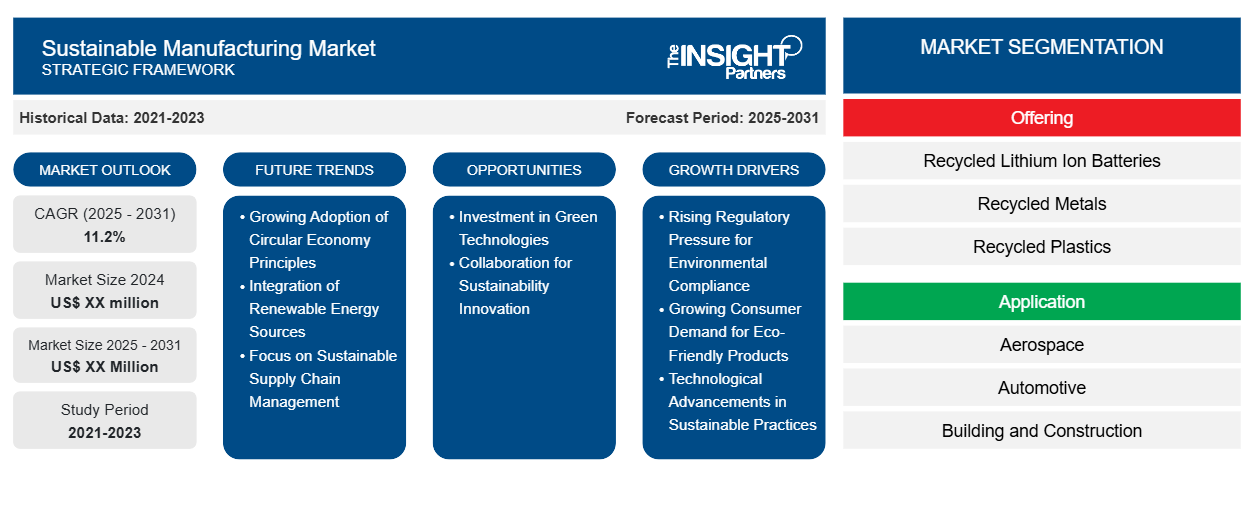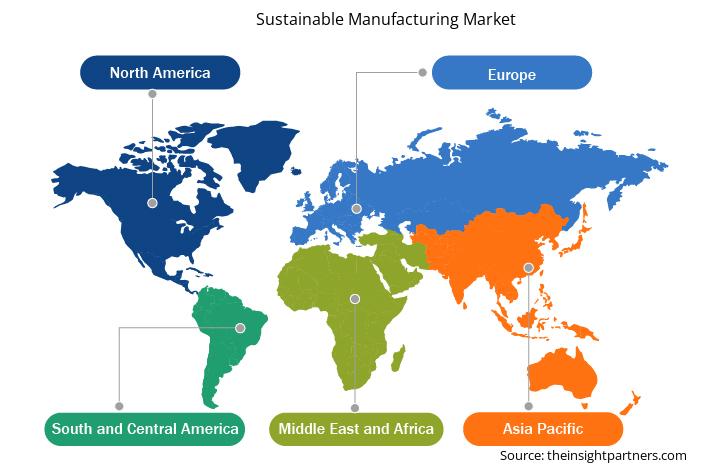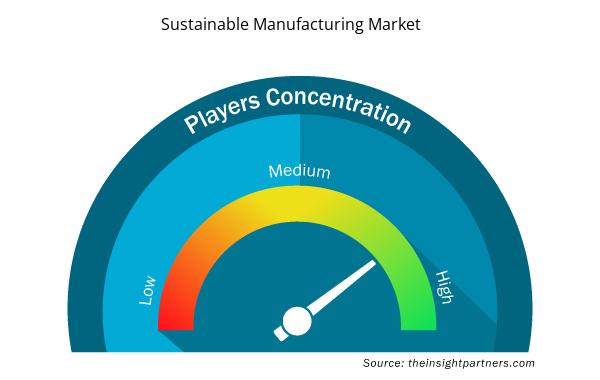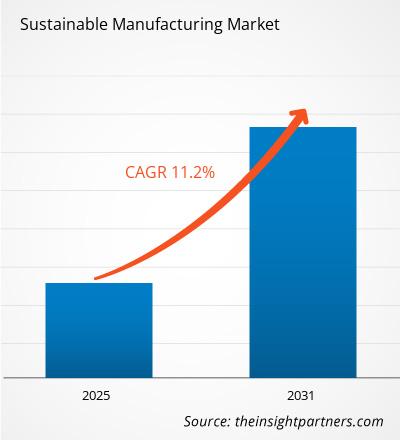持続可能な製造市場は、2025年から2031年にかけて11.2%のCAGRで成長し、市場規模は2024年のXX百万米ドルから2031年にはXX百万米ドルに拡大すると予想されています。
本レポートは、提供分野(リサイクルリチウムイオン電池、リサイクル金属、リサイクルプラスチック、リサイクル炭素繊維、天然繊維複合材、バイオプラスチックおよびバイオポリマー、水のリサイクルおよび再利用)、用途(航空宇宙、自動車、建築・建設、エネルギー、化学、海洋、包装、その他)別にセグメント化されています。グローバル分析は、地域レベルおよび主要国別にさらに細分化されています。本レポートでは、上記の分析およびセグメントの米ドル建て価値を提供しています。
報告書の目的
The Insight Partnersによるレポート「持続可能な製造業市場」は、現在の市場状況と将来の成長、主要な推進要因、課題、そして機会を解説することを目的としています。これにより、以下のような様々なビジネスステークホルダーに洞察を提供します。
- テクノロジープロバイダー/メーカー: 進化する市場の動向を理解し、潜在的な成長機会を把握することで、情報に基づいた戦略的意思決定を行うことができます。
- 投資家: 市場の成長率、市場の財務予測、バリュー チェーン全体に存在する機会に関する包括的な傾向分析を実施します。
- 規制機関: 市場の濫用を最小限に抑え、投資家の信用と信頼を維持し、市場の健全性と安定性を維持することを目的として、市場における政策と警察活動を規制します。
持続可能な製造業の市場セグメンテーション
提供
- リサイクルされたリチウムイオン電池
- リサイクル金属
- リサイクルプラスチック
- リサイクルカーボンファイバー
- 天然繊維複合材料
- バイオプラスチックとバイオポリマー
- 水のリサイクルと再利用
応用
- 航空宇宙
- 自動車
- 建築・建設
- エネルギー
- 化学薬品
- 海洋
- パッケージ
要件に合わせてレポートをカスタマイズ
このレポートの一部、国レベルの分析、Excelデータパックなど、あらゆるレポートを無料でカスタマイズできます。また、スタートアップや大学向けのお得なオファーや割引もご利用いただけます。
持続可能な製造市場:戦略的洞察

- このレポートの主要な市場動向を入手してください。この無料サンプルには、市場動向から見積もりや予測に至るまでのデータ分析が含まれます。
持続可能な製造市場の成長ドライバー
- 環境コンプライアンスへの規制圧力の高まり:世界各国政府は、気候変動対策と環境の持続可能性の促進のため、より厳しい規制を導入しています。こうした規制圧力は、持続可能な製造市場にとって大きな推進力となっています。企業は、廃棄物の削減、エネルギー効率の向上、排出量の最小化など、環境に配慮した取り組みを迫られています。これらの規制を遵守することで、企業は罰金や罰則を回避できるだけでなく、持続可能な製品を好む消費者からの評判も向上します。
- 環境に優しい製品に対する消費者の需要の高まり:環境問題への意識が高まるにつれ、持続可能な製品への消費者の嗜好が顕著に変化しています。消費者は、高品質であるだけでなく、環境に優しい製品を求める傾向が高まっています。この傾向は、メーカーが革新を起こし、持続可能な材料やプロセスを製造方法に取り入れるよう促しています。持続可能な製品への需要の高まりは、企業が顧客の期待に応えるためにサプライチェーンを見直し、より環境に優しい技術への投資を迫る要因となっています。
- 持続可能な製造業における技術革新:技術革新は、持続可能な製造業への移行を促進しています。積層造形、自動化、データ分析といった高度な製造技術は、企業のプロセス最適化と資源消費量の削減に貢献しています。例えば、機械学習を活用することで、設備の故障を予測し、ダウンタイムを最小限に抑えることで効率性を向上させることができます。これらの技術革新により、メーカーは環境への影響が少ない製品を生産できるようになり、持続可能な製造市場の成長を促進しています。
持続可能な製造市場の将来動向
- 循環型経済原則の採用拡大:持続可能な製造業における重要なトレンドとして、循環型経済原則の採用拡大が挙げられます。このアプローチは、材料の再利用、リサイクル、そして再利用により、製品のライフサイクルを延長し、廃棄物を最小限に抑えることを重視しています。メーカーは、製品の寿命を考慮し、材料を容易に分解・リサイクルできるよう設計しています。この傾向は、環境への影響を軽減するだけでなく、リサイクルおよび材料回収分野における新たなビジネスチャンスの創出にもつながっています。
- 再生可能エネルギー源の統合:もう一つの顕著なトレンドは、製造プロセスへの再生可能エネルギー源の統合です。企業は、事業運営の電力源として、太陽光、風力、その他の再生可能エネルギー技術への投資を増やしています。この移行は、温室効果ガスの排出量を削減するだけでなく、エネルギー安全保障を強化し、化石燃料への依存度を低減することにもつながります。再生可能エネルギーへの移行は、持続可能性の目標を達成するために不可欠であると考えられており、持続可能な製造業における重要なトレンドとなっています。
- 持続可能なサプライチェーン管理への注力:持続可能な製造業という広範なトレンドの一環として、持続可能なサプライチェーン管理への注目が高まっています。企業は、責任あるサプライヤーからの材料調達や輸送時の排出量削減など、持続可能性向上のための機会を特定するために、サプライチェーン全体を評価しています。この包括的なアプローチは、業務効率を向上させるだけでなく、ブランドロイヤルティの強化にもつながります。消費者は、サプライチェーン全体で持続可能性を重視する企業を好む傾向が高まっています。
持続可能な製造業の市場機会
- グリーンテクノロジーへの投資:持続可能な製造業の実践を促進するグリーンテクノロジーへの投資には、大きなチャンスがあります。革新的な素材、省エネ機械、廃棄物削減技術を開発する企業は、成長市場セグメントを獲得できる可能性があります。さらに、政府のグリーンイニシアチブに対するインセンティブや資金援助は、持続可能な製造業への移行を目指す企業を支援するため、スタートアップ企業と環境パフォーマンスの向上を目指す既存メーカーの両方にとって魅力的な分野となっています。
- サステナビリティ・イノベーションのためのコラボレーション:メーカー、研究者、そしてテクノロジープロバイダー間のコラボレーションは、持続可能な実践におけるイノベーションの大きな機会をもたらします。関係者が協力することで、知識、リソース、そしてベストプラクティスを共有し、サステナビリティの課題に対処する最先端のソリューションを開発することができます。このようなパートナーシップは、製品設計、資源効率、そして廃棄物管理におけるブレークスルーにつながり、最終的には持続可能な製造業の課題を前進させ、より回復力と競争力のある市場環境を創出します。
持続可能な製造市場の地域別洞察
予測期間全体を通して持続可能な製造市場に影響を与える地域的な傾向と要因は、Insight Partnersのアナリストによって徹底的に説明されています。このセクションでは、北米、ヨーロッパ、アジア太平洋、中東・アフリカ、中南米における持続可能な製造市場のセグメントと地域についても説明します。

- 持続可能な製造市場の地域別データを入手
持続可能な製造業の市場レポートの範囲
| レポート属性 | 詳細 |
|---|---|
| 2024年の市場規模 | XX百万米ドル |
| 2031年までの市場規模 | XX百万米ドル |
| 世界のCAGR(2025年~2031年) | 11.2% |
| 履歴データ | 2021-2023 |
| 予測期間 | 2025~2031年 |
| 対象セグメント | 提供することで
|
| 対象地域と国 | 北米
|
| 市場リーダーと主要企業の概要 |
|
持続可能な製造業の市場プレーヤーの密度:ビジネスダイナミクスへの影響を理解する
持続可能な製造市場は、消費者の嗜好の変化、技術の進歩、製品の利点に対する認知度の高まりといった要因によるエンドユーザーの需要増加に牽引され、急速に成長しています。需要の増加に伴い、企業は提供内容を拡大し、消費者ニーズを満たすための革新を進め、新たなトレンドを活用しており、これが市場の成長をさらに加速させています。
市場プレーヤー密度とは、特定の市場または業界内で事業を展開する企業または会社の分布を指します。これは、特定の市場空間における競合企業(市場プレーヤー)の数が、その市場規模または市場価値全体と比較してどれだけ多いかを示します。
持続可能な製造市場で事業を展開している主要企業は次のとおりです。
- ACCUREC-Recycling GmbH
- アルセロール・ミッタル
- ベリーグローバル株式会社
- ビッファ・リミテッド
- ブラスケム
免責事項:上記の企業は、特定の順序でランク付けされているわけではありません。

- 持続可能な製造市場の主要な主要プレーヤーの概要を入手
主なセールスポイント
- 包括的なカバレッジ: レポートでは、持続可能な製造市場の製品、サービス、タイプ、エンドユーザーの分析を包括的にカバーし、全体的な展望を提供します。
- 専門家の分析:レポートは、業界の専門家とアナリストの深い理解に基づいて作成されています。
- 最新情報: このレポートは、最新の情報とデータの傾向を網羅しているため、ビジネスの関連性を保証します。
- カスタマイズ オプション: このレポートは、特定のクライアント要件に対応し、ビジネス戦略に適切に適合するようにカスタマイズできます。
したがって、持続可能な製造市場に関する調査レポートは、業界の状況と成長見通しを解明し、理解するための先導役となるでしょう。いくつかの妥当な懸念事項はあるものの、このレポートの全体的なメリットはデメリットを上回る傾向にあります。
- 過去2年間の分析、基準年、CAGRによる予測(7年間)
- PEST分析とSWOT分析
- 市場規模価値/数量 - 世界、地域、国
- 業界と競争環境
- Excel データセット


- Transdermal Drug Delivery System Market
- Aerospace Forging Market
- Cut Flowers Market
- Formwork System Market
- Print Management Software Market
- Explosion-Proof Equipment Market
- Enteral Nutrition Market
- Single-Use Negative Pressure Wound Therapy Devices Market
- Enzymatic DNA Synthesis Market
- UV Curing System Market

Report Coverage
Revenue forecast, Company Analysis, Industry landscape, Growth factors, and Trends

Segment Covered
This text is related
to segments covered.

Regional Scope
North America, Europe, Asia Pacific, Middle East & Africa, South & Central America

Country Scope
This text is related
to country scope.
よくある質問
The report can be delivered in PDF/PPT format; we can also share excel dataset based on the request.
The leading players operating in the Sustainable Manufacturing Market include ACCUREC-Recycling GmbH, ArcelorMittal, Berry Global Inc., Biffa Limited, Braskem, Cirba Solutions, Dow Inc., Ecobat Battery, Veolia, Umicore
Growing Adoption of Circular Economy Principles, Integration of Renewable Energy Sources, Focus on Sustainable Supply Chain Management is the key future trend of the Sustainable Manufacturing Market
The major factors driving the Sustainable Manufacturing Market is Rising Regulatory Pressure for Environmental Compliance, Growing Consumer Demand for Eco-Friendly Products, Technological Advancements in Sustainable Practices.
The global Sustainable Manufacturing Market is expected to grow at a CAGR of 11.2% during the forecast period 2024 - 2031.
Trends and growth analysis reports related to Manufacturing and Construction : READ MORE..
The Insight Partners performs research in 4 major stages: Data Collection & Secondary Research, Primary Research, Data Analysis and Data Triangulation & Final Review.
- Data Collection and Secondary Research:
As a market research and consulting firm operating from a decade, we have published and advised several client across the globe. First step for any study will start with an assessment of currently available data and insights from existing reports. Further, historical and current market information is collected from Investor Presentations, Annual Reports, SEC Filings, etc., and other information related to company’s performance and market positioning are gathered from Paid Databases (Factiva, Hoovers, and Reuters) and various other publications available in public domain.
Several associations trade associates, technical forums, institutes, societies and organization are accessed to gain technical as well as market related insights through their publications such as research papers, blogs and press releases related to the studies are referred to get cues about the market. Further, white papers, journals, magazines, and other news articles published in last 3 years are scrutinized and analyzed to understand the current market trends.
- Primary Research:
The primarily interview analysis comprise of data obtained from industry participants interview and answers to survey questions gathered by in-house primary team.
For primary research, interviews are conducted with industry experts/CEOs/Marketing Managers/VPs/Subject Matter Experts from both demand and supply side to get a 360-degree view of the market. The primary team conducts several interviews based on the complexity of the markets to understand the various market trends and dynamics which makes research more credible and precise.
A typical research interview fulfils the following functions:
- Provides first-hand information on the market size, market trends, growth trends, competitive landscape, and outlook
- Validates and strengthens in-house secondary research findings
- Develops the analysis team’s expertise and market understanding
Primary research involves email interactions and telephone interviews for each market, category, segment, and sub-segment across geographies. The participants who typically take part in such a process include, but are not limited to:
- Industry participants: VPs, business development managers, market intelligence managers and national sales managers
- Outside experts: Valuation experts, research analysts and key opinion leaders specializing in the electronics and semiconductor industry.
Below is the breakup of our primary respondents by company, designation, and region:

Once we receive the confirmation from primary research sources or primary respondents, we finalize the base year market estimation and forecast the data as per the macroeconomic and microeconomic factors assessed during data collection.
- Data Analysis:
Once data is validated through both secondary as well as primary respondents, we finalize the market estimations by hypothesis formulation and factor analysis at regional and country level.
- Macro-Economic Factor Analysis:
We analyse macroeconomic indicators such the gross domestic product (GDP), increase in the demand for goods and services across industries, technological advancement, regional economic growth, governmental policies, the influence of COVID-19, PEST analysis, and other aspects. This analysis aids in setting benchmarks for various nations/regions and approximating market splits. Additionally, the general trend of the aforementioned components aid in determining the market's development possibilities.
- Country Level Data:
Various factors that are especially aligned to the country are taken into account to determine the market size for a certain area and country, including the presence of vendors, such as headquarters and offices, the country's GDP, demand patterns, and industry growth. To comprehend the market dynamics for the nation, a number of growth variables, inhibitors, application areas, and current market trends are researched. The aforementioned elements aid in determining the country's overall market's growth potential.
- Company Profile:
The “Table of Contents” is formulated by listing and analyzing more than 25 - 30 companies operating in the market ecosystem across geographies. However, we profile only 10 companies as a standard practice in our syndicate reports. These 10 companies comprise leading, emerging, and regional players. Nonetheless, our analysis is not restricted to the 10 listed companies, we also analyze other companies present in the market to develop a holistic view and understand the prevailing trends. The “Company Profiles” section in the report covers key facts, business description, products & services, financial information, SWOT analysis, and key developments. The financial information presented is extracted from the annual reports and official documents of the publicly listed companies. Upon collecting the information for the sections of respective companies, we verify them via various primary sources and then compile the data in respective company profiles. The company level information helps us in deriving the base number as well as in forecasting the market size.
- Developing Base Number:
Aggregation of sales statistics (2020-2022) and macro-economic factor, and other secondary and primary research insights are utilized to arrive at base number and related market shares for 2022. The data gaps are identified in this step and relevant market data is analyzed, collected from paid primary interviews or databases. On finalizing the base year market size, forecasts are developed on the basis of macro-economic, industry and market growth factors and company level analysis.
- Data Triangulation and Final Review:
The market findings and base year market size calculations are validated from supply as well as demand side. Demand side validations are based on macro-economic factor analysis and benchmarks for respective regions and countries. In case of supply side validations, revenues of major companies are estimated (in case not available) based on industry benchmark, approximate number of employees, product portfolio, and primary interviews revenues are gathered. Further revenue from target product/service segment is assessed to avoid overshooting of market statistics. In case of heavy deviations between supply and demand side values, all thes steps are repeated to achieve synchronization.
We follow an iterative model, wherein we share our research findings with Subject Matter Experts (SME’s) and Key Opinion Leaders (KOLs) until consensus view of the market is not formulated – this model negates any drastic deviation in the opinions of experts. Only validated and universally acceptable research findings are quoted in our reports.
We have important check points that we use to validate our research findings – which we call – data triangulation, where we validate the information, we generate from secondary sources with primary interviews and then we re-validate with our internal data bases and Subject matter experts. This comprehensive model enables us to deliver high quality, reliable data in shortest possible time.

 このレポートの無料サンプルを入手する
このレポートの無料サンプルを入手する